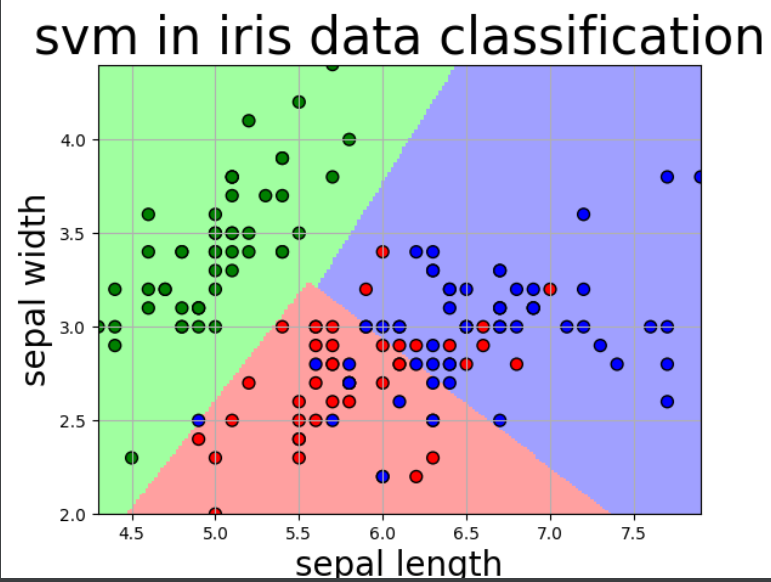深度学习经典应用——鸢尾花分类(基于sklearn包)+三维成果可视化
文章目录
任务描述
构建一个模型,根据鸢尾花的花萼和花瓣大小将其分为三种不同的品种
数据集
总共包含150行数据
每一行数据由 4 个特征值及一个目标值组成。
4 个特征值分别为:萼片长度、萼片宽度、花瓣长度、花瓣宽度
目标值为三种不同类别的鸢尾花,分别为: Iris setosa、Iris versicolour、Iris virginica

首先导入必要的包:
numpy : python第三方库,用于科学计算
matplotlib : python第三方库,主要用于进行可视化
sklearn: python的重要机器学习库,其中封装了大量的机器学习算法,如:分类、回归、降维以及聚类
import numpy as np
from matplotlib import colors
from sklearn import svm
from sklearn.svm import SVC
from sklearn import model_selection
import matplotlib.pyplot as plt
import matplotlib as mpl
Step1. 数据准备
- 从指定路径下加载数据
- 对加载的数据进行数据分割,
x_train,y_train,x_test,y_test分别表示训练集特征、训练集标签、测试集特征、测试集标签
#将字符串转为整型,便于数据加载
#这是一个字典
def iris_type(s):
it = {b'Iris-setosa':0, b'Iris-versicolor':1, b'Iris-virginica':2}
return it[s]
b' '表示这是一个 bytes 对象,用在Python3中,Python3里默认的str是unicode类。Python2的str本身就是bytes类。
#加载数据
data_path='/home/aistudio/data/data2301/iris.data' #数据文件的路径
data = np.loadtxt(data_path, #数据文件路径
dtype=float, #数据类型
delimiter=',', #数据分隔符
converters={4:iris_type}) #将第5列使用函数iris_type进行转换,预处理
#print(data) #data为二维数组,data.shape=(150, 5)
#print(data.shape)
#数据分割
x, y = np.split(data, #要切分的数组
(4,), #沿轴切分的位置,第5列开始往后为y
axis=1) #代表纵向分割,按列分割
x = x[:, 0:2]
#在X中我们取前两列作为特征,为了后面的可视化。x[:,0:2]代表第一维(行)全取,第二维(列)取0~2
#如果想取0,2,3列,x = np.stack((x[:, 0], x[:, 2], x[:, 3]), axis=1)
#print(x)
x_train, x_test, y_train, y_test = model_selection.train_test_split(x,
y,
random_state=1,
test_size=0.3)
#x为所要划分的样本特征集
#y为所要划分的样本结果,0,1,2
#random_state随机数种子,就是把数据打乱
#test_size测试样本占比
Step2. 模型搭建
C : float,可选(默认值= 1.0)
错误术语的惩罚参数C。C越大,相当于惩罚松弛变量,希望松弛变量接近0,即对误分类的惩罚增大,趋向于对训练集全分对的情况,这样对训练集测试时准确率很高,但泛化能力弱。C值小,对误分类的惩罚减小,允许容错,将他们当成噪声点,泛化能力较强。
kernel : string,optional(default =‘rbf’)
核函数类型,str类型,默认为’rbf’。可选参数为:
’linear’:线性核函数
‘poly’:多项式核函数
‘rbf’:径像核函数/高斯核
‘sigmod’:sigmod核函数
‘precomputed’:核矩阵
precomputed表示自己提前计算好核函数矩阵,这时候算法内部就不再用核函数去计算核矩阵,而是直接用你给的核矩阵,核矩阵需要为n*n的。
decision_function_shape : ‘ovo’,‘ovr’,默认= ‘ovr’决策函数类型,可选参数 ’ovo’ 和 ’ovr’ ,默认为 ’ovr’ 。
decision_function_shape= 'ovr’时,为one v rest,即一个类别与其他类别进行划分,
decision_function_shape= 'ovo’时,为one v one,即将类别两两之间进行划分,用二分类的方法模拟多分 类的结果。
# SVM分类器构建
def classifier():
#clf = svm.SVC(C=0.8,kernel='rbf', gamma=50,decision_function_shape='ovr')
clf = svm.SVC(C=0.5, #误差项惩罚系数,默认值是1
kernel='linear', #线性核 kenrel="rbf":高斯核
decision_function_shape='ovr') #决策函数
return clf
# 定义模型:SVM模型定义
clf = classifier()
Step3.模型训练
#训练模型
def train(clf,x_train,y_train):
clf.fit(x_train, #训练集特征向量
y_train.ravel()) #训练集目标值
# 训练SVM模型
train(clf,x_train,y_train)
fit()方法用于训练svm,具体参数已经在定义svc对象时给出,这时候只需要给出数据集x和x对应的标签y。
ravel()方法将数组维度拉成一维数组
Step4. 模型评估
#判断a b是否相等,计算acc的均值
def show_accuracy(a, b, tip):
acc = a.ravel() == b.ravel() #acc是一个包含很多1,0的数组
print('%s Accuracy:%.3f' %(tip, np.mean(acc))) #np.mean()用来求均值
def print_accuracy(clf,x_train,y_train,x_test,y_test):
#打印训练集和测试集的准确率score(x_train,y_train):表示输出x_train,y_train在模型上的准确率
print('trianing prediction:%.3f' %(clf.score(x_train, y_train)))
print('test data prediction:%.3f' %(clf.score(x_test, y_test)))
#原始结果与预测结果进行对比 predict()表示对x_train样本进行预测,返回样本类别
show_accuracy(clf.predict(x_train), y_train, 'traing data')
show_accuracy(clf.predict(x_test), y_test, 'testing data')
#计算决策函数的值,表示x到各分割平面的距离
print('decision_function:\n', clf.decision_function(x_train))
print_accuracy(clf, x_train, y_train, x_test, y_test)

scikit-learn工具包中分类模型predict_proba、predict、decision_function用法详解_ 原理介绍很赞
Step5. 模型使用
def draw(clf, x):
iris_feature = 'sepal length', 'sepal width', 'petal lenght', 'petal width'
# 开始画图
x1_min, x1_max = x[:, 0].min(), x[:, 0].max() #第0列的范围
x2_min, x2_max = x[:, 1].min(), x[:, 1].max() #第1列的范围
x1, x2 = np.mgrid[x1_min:x1_max:200j, x2_min:x2_max:200j] #生成网格采样点,2D
grid_test = np.stack((x1.flat, x2.flat), axis=1) #stack():沿着新的轴加入一系列数组, flat的作用是将数组分解成可连续访问的元素,目的就是把他拉直后合并,并且不改变数组
print('grid_test:\n', grid_test)
# 输出样本到决策面的距离
z = clf.decision_function(grid_test)
print('the distance to decision plane:\n', z)
grid_hat = clf.predict(grid_test) # 预测分类值 得到【0,0.。。。2,2,2】
print('grid_hat:\n', grid_hat)
grid_hat = grid_hat.reshape(x1.shape) # reshape grid_hat和x1形状一致
#若3*3矩阵e,则e.shape()为3*3,表示3行3列
cm_light = mpl.colors.ListedColormap(['#A0FFA0', '#FFA0A0', '#A0A0FF'])
cm_dark = mpl.colors.ListedColormap(['g', 'r', 'b'])
plt.pcolormesh(x1, x2, grid_hat, cmap=cm_light) # pcolormesh(x,y,z,cmap)这里参数代入x1,x2,grid_hat,cmap=cm_light绘制的是背景。
plt.scatter(x[:, 0], x[:, 1], c=np.squeeze(y), edgecolor='k', s=50, cmap=cm_dark) # 样本点
plt.scatter(x_test[:, 0], x_test[:, 1], s=120, facecolor='none', zorder=10) # 测试点
plt.xlabel(iris_feature[0], fontsize=20) #x轴名称
plt.ylabel(iris_feature[1], fontsize=20)
plt.xlim(x1_min, x1_max) #x轴作图范围
plt.ylim(x2_min, x2_max)
plt.title('svm in iris data classification', fontsize=30)
plt.grid()
plt.show()
# 模型使用
draw(clf,x)
#输出
grid_test:
[[4.3 2. ]
[4.3 2.0120603]
[4.3 2.0241206]
...
[7.9 4.3758794]
[7.9 4.3879397]
[7.9 4.4 ]]
the distance to decision plane:
[[ 2.17689921 1.23467171 -0.25941323]
[ 2.17943684 1.23363096 -0.25941107]
[ 2.18189345 1.23256802 -0.25940892]
...
[-0.27958977 0.83621535 2.28683228]
[-0.27928358 0.8332275 2.28683314]
[-0.27897389 0.83034313 2.28683399]]
grid_hat:
[0. 0. 0. ... 2. 2. 2.]

若训练的不是0,1列,而是2,3列,则模型准确率会提高


若训练所有列,准确率达到最高

3D可视化模型
现在挑选0,2,3列进行3维的建模
#用如下代码代替之前的分割数据的代码 原:x = x[:, 0:2]
x = np.stack((x[:, 0], x[:, 2], x[:, 3]), axis=1)
def draw(clf, x):
iris_feature = 'sepal length', 'sepal width', 'petal lenght', 'petal width'
# 开始画图
x0_min, x0_max = x[:, 0].min(), x[:, 0].max()
x1_min, x1_max = x[:, 1].min(), x[:, 1].max() # 第0列的范围
x2_min, x2_max = x[:, 2].min(), x[:, 2].max() # 第1列的范围
x0, x1, x2 = np.mgrid[x0_min:x0_max:50j, x1_min:x1_max:50j, x2_min:x2_max:50j] # 生成网格采样点,3D
grid_test = np.stack((x0.flat, x1.flat, x2.flat), axis=1) # stack():沿着新的轴加入一系列数组, flat的作用是将数组分解成可连续访问的元素,目的就是把他拉直后合并,并且不改变数组
print('grid_test:\n', grid_test)
grid_hat = clf.predict(grid_test) # 预测分类值 得到【0,0.。。。2,2,2】
print('grid_hat:\n', grid_hat)
grid_hat = grid_hat.reshape(x1.shape) # reshape grid_hat和x1形状一致
# 若3*3矩阵e,则e.shape()为3*3,表示3行3列
cm_light = mpl.colors.ListedColormap(['#A0FFA0', '#FFA0A0', '#A0A0FF'])
cm_dark = mpl.colors.ListedColormap(['g', 'r', 'b'])
fig = plt.figure()
ax = fig.add_subplot(projection='3d')
# s:marker标记的大小
# c: 颜色 可为单个,可为序列
# depthshade: 是否为散点标记着色以呈现深度外观。对 scatter() 的每次调用都将独立执行其深度着色。
# marker:样式
# alpha为点的透明度,在0~1之间
ax.scatter(xs=x1, ys=x2, zs=x0, zdir='z', s=10, c=grid_hat, depthshade=True, cmap=cm_light,alpha=0.01)
ax.scatter(xs=x[:,1], ys=x[:,2], zs=x[:,0], zdir='z', s=30, c=np.squeeze(y), depthshade=True, cmap=cm_dark, marker="^")
plt.show()
draw(clf, x)
结果如下




![【深度学习】“OSError [WinError 1455]页面文件太小,无法完成操作”解决方案](https://i3.wp.com/img-blog.csdnimg.cn/321d7c90eb9f4e4286ff9456500e78b6.png#pic_center)
